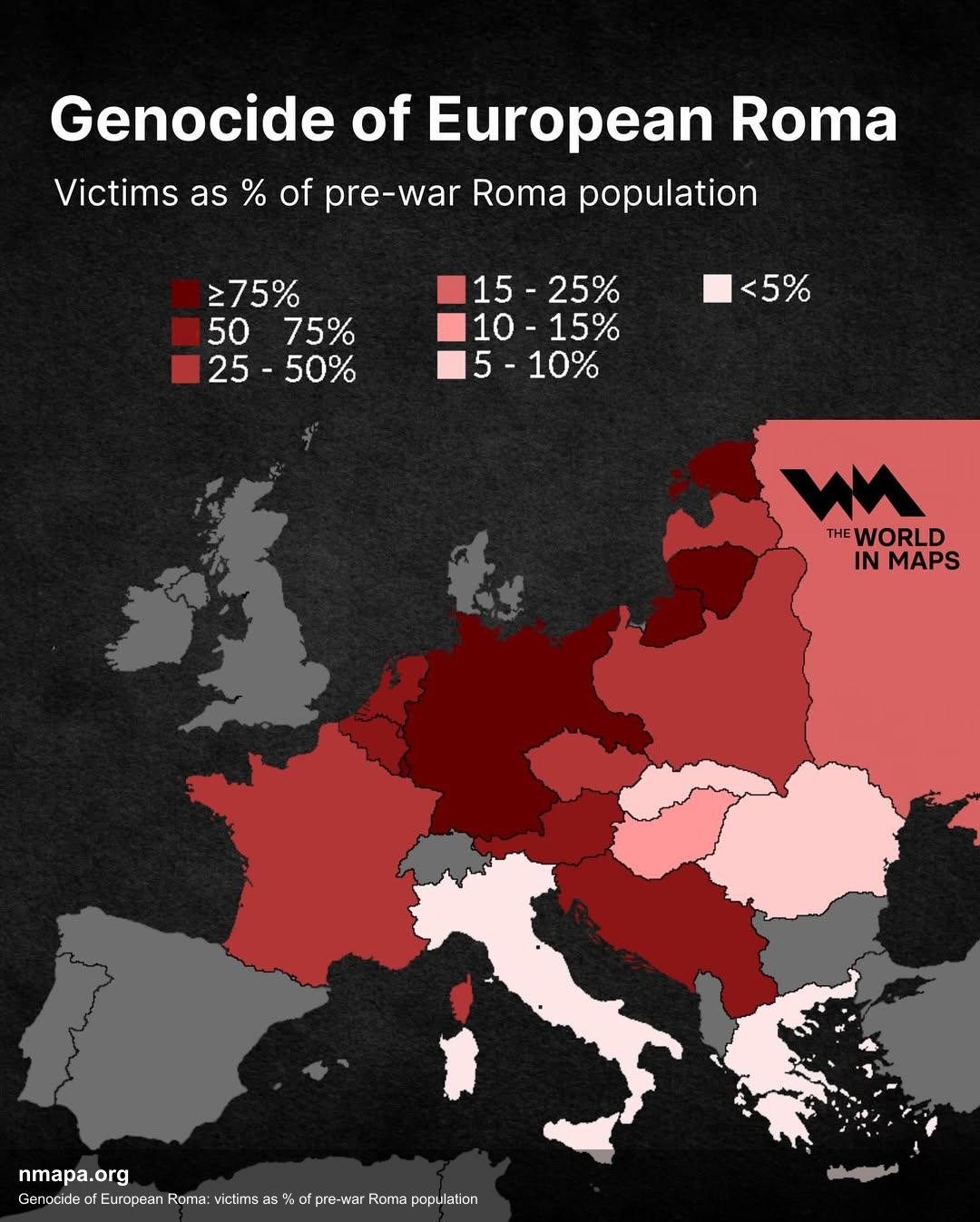Genocide of European Roma Victims Map


Alex Cartwright
Senior Cartographer & GIS Specialist
Alex Cartwright is a renowned cartographer and geographic information systems specialist with over 15 years of experience in spatial analysis and data...
Geographic Analysis
What This Map Shows
The "Genocide of European Roma: Victims as % of Pre-war Roma Population" map provides a stark visual representation of the devastating impact of the Holocaust on the Romani people across Europe. This visualization captures the percentage of Roma victims compared to their pre-war population in various European countries, shedding light on an often-overlooked aspect of World War II history. The map highlights the scale of the tragedy, illustrating not just numbers but the profound loss of culture, community, and identity.
Deep Dive into the Genocide of the Roma
The systematic persecution of the Romani people during the Holocaust, often referred to as the Porajmos, is a dark chapter in European history. Unlike the more widely recognized atrocities faced by Jewish communities, the genocide of the Roma has received less attention, despite its equally horrific scale and implications. Estimates suggest that approximately 1.5 million Roma were killed during this period, a staggering loss that represented a significant portion of their population across Europe.
The Romani people, traditionally marginalized and discriminated against, faced extensive persecution before and during the war. Nazi ideology deemed them racially inferior, leading to policies aimed at their extermination. Countries such as Germany, Poland, and Hungary exhibited particularly high levels of violence against Roma, as shown on the map. For instance, in Hungary, up to 90% of the pre-war Roma population was annihilated. This statistic is not just a number; it represents families, histories, and cultures that were obliterated.
Interestingly, the map reveals regional variations in victimization rates, reflecting the different policies and levels of brutality enacted by various governments. In countries like Slovakia and the Czech Republic, significant percentages of Roma were also killed, while some nations, such as France, displayed lower percentages, likely due to differing wartime circumstances and resistances.
Moreover, the map prompts us to consider the long-term effects of such a tragedy. The loss of language, traditions, and familial structures continues to be felt within Romani communities today. Have you ever wondered how such historical trauma shapes contemporary identity? The answer lies in the ongoing struggle for recognition and rights among Romani people, who continue to face discrimination and marginalization in many parts of Europe.
Regional Analysis
Examining the map more closely, we can categorize the impact of the genocide across different regions. In Eastern Europe, countries like Poland and Romania experienced severe losses, with estimates indicating that up to 80% of the Roma population was exterminated. The implications of these losses are profound, as entire communities were eradicated, leaving a cultural void that is still being felt today.
In contrast, Western European countries had varying experiences, influenced by factors such as resistance movements and different Nazi occupation strategies. For example, in France, while the percentage of Roma killed was lower, the community still faced significant persecution and forced relocations. The map illustrates these dynamics clearly, allowing us to compare and contrast the experiences of Roma in different national contexts.
Furthermore, the map also highlights the resilience of Romani culture, which, despite the tragic losses, has persisted in various forms. Contemporary Roma activism across Europe seeks to reclaim history and advocate for rights, making it crucial to understand these historical contexts.
Significance and Impact
Understanding the genocide of the Roma is vital not only for historical accuracy but also for acknowledging the ongoing struggles faced by their descendants. The map serves as a powerful reminder of the past, urging us to confront uncomfortable truths about prejudice and racism that persist today. What's fascinating is how this historical examination can lead to meaningful dialogues about inclusion, diversity, and human rights in contemporary society.
As we reflect on the implications of such a significant loss, we must also consider the importance of preserving Roma culture and history. Initiatives aimed at education, cultural celebration, and advocacy are crucial in ensuring that the stories of those who perished are not forgotten, and that the rights of Romani people are protected moving forward. In a world where history often repeats itself, recognizing these patterns is essential for fostering a more just and equitable society.
In conclusion, the "Genocide of European Roma: Victims as % of Pre-war Roma Population" map is not just a visualization; it is a call to remember and honor those who suffered immense losses. It urges us to reflect on our collective responsibility to ensure that such atrocities are never repeated and that the voices of marginalized communities are heard.
Visualization Details
- Published
- August 2, 2025
- Views
- 164
Comments
Loading comments...